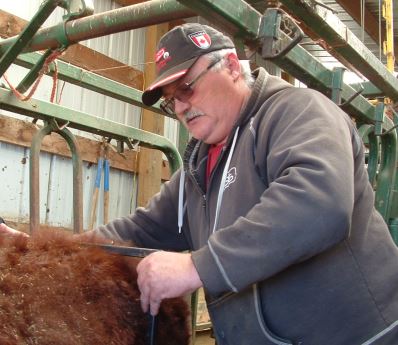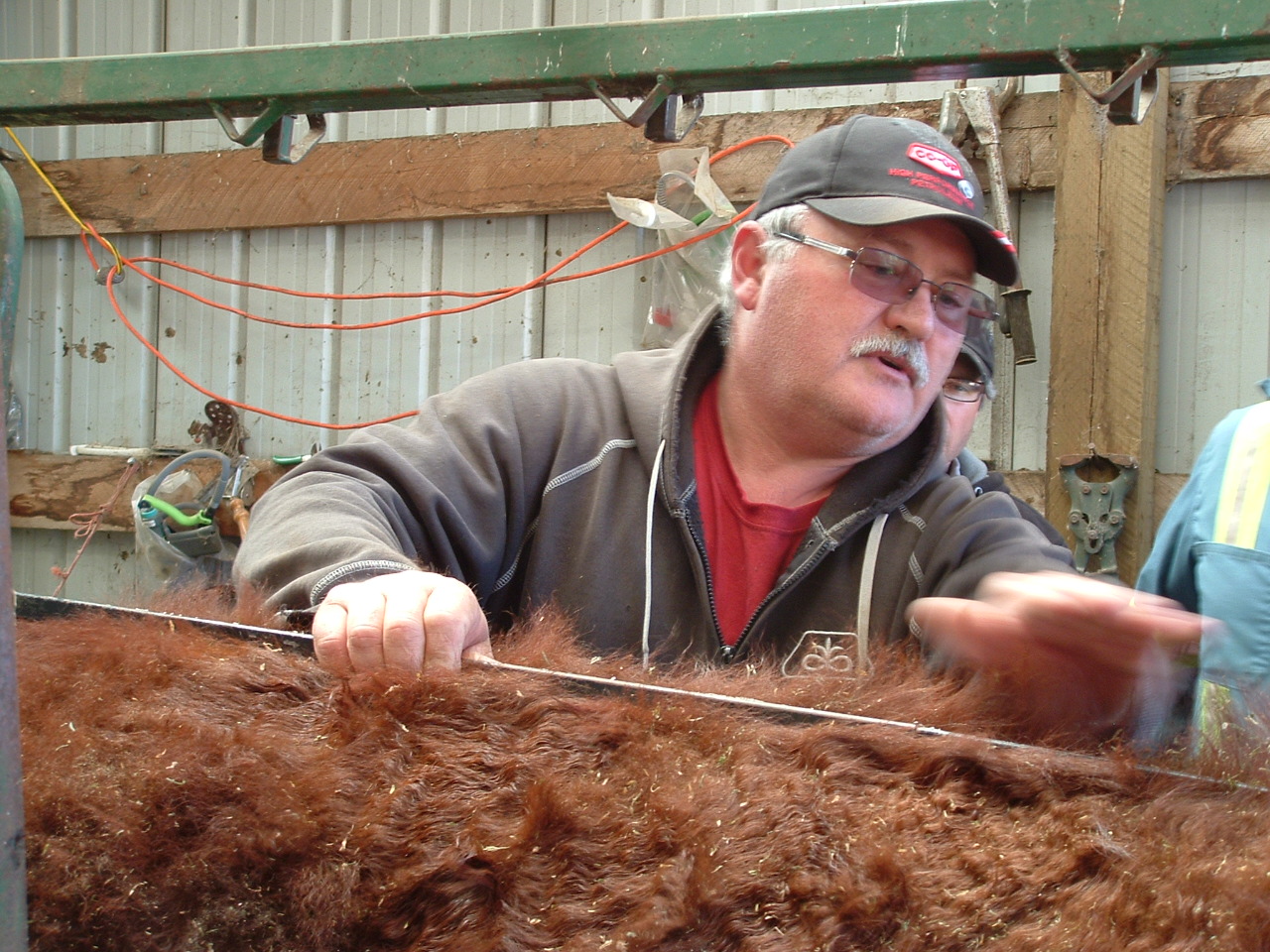



Linear Measuring Improves Genetics of Grass-Fed Cattle
CANADA - Beef producer, Brian Harper, demonstrates how Linear Measuring can be used to select cows that will perform best on grass to other producers on his farm near Brandon, Manitoba.As North American demand grass fed beef continues to grow, some Canadian producers are rethinking their cattle genetics to select for animals that will be the most productive on forages.
Brian Harper has been using Linear Measuring as part of his genetic selection process since 2007 and has seen steady improvements in the quality of his grass-fed herd.

Harper raises Lincoln Red and Shaver Beefblend cattle near Brandon in Western Manitoba, and breeds only the top 10 per cent of his cows – determined through Linear Measuring – with his premier sire to maximize the best genetics.
“You can’t improve your cow herd by just culling,” says Harper. “You need to select from the top, and that starts by using the bull with the most prepotent paternal genetics you can find, and always breeding him with your best cows. It may take a few generations to get what you need but I’ve seen definite improvements in the quality and efficiency of my herd over the past five years.”
Linear Measuring is a tool that enables the producer to identify structural weaknesses and strengths that are genetic, and thus inheritable.
Linear Measuring shows how different body measurements correlate to indicators of potential fertility and production efficiency.
The process allows producers to select bulls and cows for breeding that have the highest levels of reproduction, the best ability to efficiently utilize grass, low maintenance requirements, and the ability to produce prime quality meat.
Harper takes measurements of the rump, body length, neck, shoulders and heart girth with specially designed calipers, and feeds the measurements into a computer program which ranks the cows or bulls according to the measurements. From this ranking, Harper picks animals with the most desirable genetics for his breeding program.
The Ideal Grass-Fed Cow
“The ideal cow that will perform well on grass should have a rump that is wider than the rump length,” says Harper.
“As well, wide shoulders equal to the rump length, and a deep chest or large heart girth, which is larger than the total topline, will provide optimal grass utilization.” Harper says every extra inch of girth that is greater than the topline equates to 37 pounds more meat, and conversely, every inch of girth that is less than the total topline equals a deficit of 37 pounds of meat.
Harper also wants cows that produce milk high in butterfat. “The average beef cow today produces about eight ounces of butterfat a day, which is around four per cent of butterfat content in the milk. Her calf receiving eight ounces a day will have an approximate average daily gain of about 1.6 lbs/day.
We need our cows to produce 13 to 16 ounces of butterfat a day – or greater than 6 per cent butterfat content – to achieve an average daily gain of 2.25 to 2.5 lbs/day,” says Harper. “The calf requires the high nutrition found in its mother’s butterfat for at least ten months to give its gut time to develop so it’s ready to process forages alone, and produce an efficient, low maintenance animal.”
A Superior Sire
An ideal bull will have shoulders that are wider than its rump length. “A wide-shouldered bull produces more sperm cells and live semen, and his calves will be born on time, and within five per cent of his actual birth weight,” he says. “His daughters will also have wider rumps indicative of high fertility. The aim of these selection and breeding practices is to make his sons genetically superior to him, so they can eventually replace him as the lead sires for the herd.”
Linear Measuring was developed by Dr. Jan Bonsma of Pretoria, South Africa during his many years of research to develop the Bonsmara cattle breed - a cross of native South African and European breeds which produce high quality meat and thrive under drought and harsh conditions.
Harper continues to improve the genetics of his herd by using Linear Measuring. “When I first started I wouldn’t use a bull that scored less than a three on the Linear Measuring ranking, but now I won’t use one scoring under 3.5, which shows how the breeding program is making progress,” he says.
For more information about Linear Measuring contact Brian Harper at [email protected]

Cow Measurements
The following explains Linear Measuring for cows and gives recommendations for ideal measurements to maximize productivity on forages.
Rump length – measured from the rump to the hip. Should ideally be 38 to 40 per cent of body length.
Rump width – should be a minimum of 2.5 inches wider than the rump length by 12 months of age to give higher fertility and fewer calving problems.
Rump height – a frame score of 4 (around 48 inches) is recommended.
Body length – a 2/3 measurement from a spot in between the shoulder blades to the rump. When the body is too long the loin becomes stretched and irregular and produces less meat.
Neck length – from the body measurement point to the poll of the head. Should be half of the body length or one-third of the topline.
Shoulder width – should be at least equal to rump length.
Heart Girth – should be equal or greater than the topline for improved vigor, adaptability and forage efficiency. A narrow, pinched girth creates glandular dysfunction making the cow and its calves more susceptible to stress and disease.
Flank – should be two inches to 10 inches larger than the heart girth.
Bull measurements
Linear Measuring and measurement recommendations for bulls are the same as for cows, with the exception of the following:
Shoulder width – To be considered superior, a bull should be at least six to eight inches wider in the shoulder than the rump length, with a minimum allowance of 2.5 inches wider than the rump length.
Rump width percentage – to determine the percentage, divide the rump width by the rump height. For the best sires the goal is to have a minimum rump width of 44 per cent, with 46 to 50 per cent of his rump height being ideal.
Flank - should be equal to total topline.
Heart Girth - Should be two inches or greater than topline for maximum meat production, adaptability, fertility and performance on grass.
TheCattleSite News Desk



